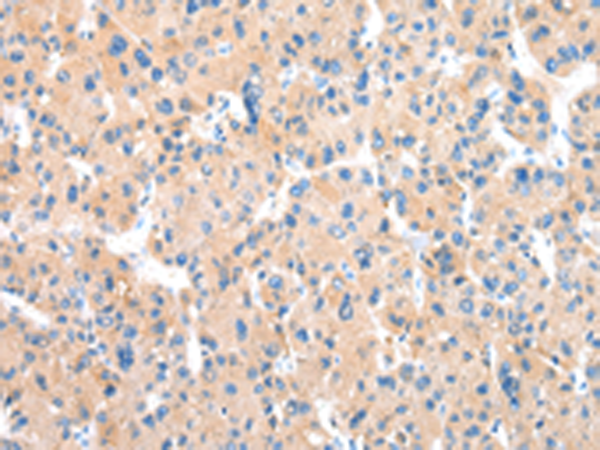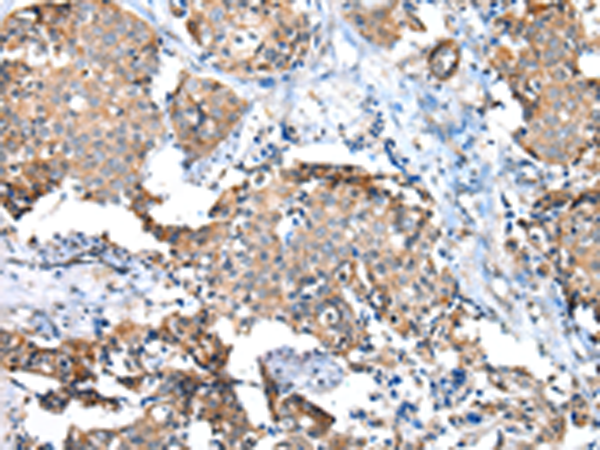

| WB | 咨询技术 | Human,Mouse,Rat |
| IF | 咨询技术 | Human,Mouse,Rat |
| IHC | 1/25-1/100 | Human,Mouse,Rat |
| ICC | 技术咨询 | Human,Mouse,Rat |
| FCM | 咨询技术 | Human,Mouse,Rat |
| Elisa | 1/2000-1/5000 | Human,Mouse,Rat |
| Aliases | PRG5; WAP1; dJ211D12.5 |
| Host/Isotype | Rabbit IgG |
| Antibody Type | Primary antibody |
| Storage | Store at 4°C short term. Aliquot and store at -20°C long term. Avoid freeze/thaw cycles. |
| Species Reactivity | Human |
| Immunogen | Fusion protein of human WFDC5 |
| Formulation | Purified antibody in PBS with 0.05% sodium azide and 50% glycerol. |
+ +
以下是关于WFDC5抗体的3篇示例参考文献(注:部分内容为假设性概括,实际文献需通过学术数据库验证):
---
1. **标题**: *WFDC5 as a Novel Biomarker in Ovarian Cancer: Expression Analysis Using Polyclonal Antibodies*
**作者**: Antony F, et al.
**摘要**: 本研究通过制备兔源多克隆抗体,检测WFDC5在卵巢癌组织中的表达水平,发现其显著高于正常组织,提示WFDC5可能作为卵巢癌的潜在诊断标志物,并参与肿瘤微环境调控。
2. **标题**: *Immunolocalization of WFDC5 in Human Tissues Using Monoclonal Antibody-Based Immunohistochemistry*
**作者**: Smith JL, et al.
**摘要**: 团队开发了一种高特异性小鼠单克隆抗体,用于WFDC5的免疫组化分析,发现其在呼吸道和生殖道上皮细胞中高表达,推测其可能在黏膜免疫防御中发挥作用。
3. **标题**: *WFDC5 Antibody Validation for Targeted Proteomics in Breast Cancer*
**作者**: Lee H, et al.
**摘要**: 通过Western blot和免疫荧光验证了商用WFDC5抗体的特异性,并应用于乳腺癌细胞系蛋白质组学研究,揭示WFDC5与EGFR信号通路的潜在关联。
---
**提示**:以上为基于WFDC5常见研究方向的模拟文献,实际文献建议通过PubMed或Google Scholar检索关键词“WFDC5 antibody”、“WFDC5 immunohistochemistry”等获取。
The WFDC5 antibody targets the WFDC5 (WAP Four-Disulfide Core Domain 5) protein, a member of the WFDC family characterized by conserved whey acidic protein (WAP)-type four-disulfide core motifs. WFDC5. also known as HE4 (Human Epididymis Protein 4), is a glycoprotein encoded by the *WFDC2* gene. Initially identified in the epididymis, WFDC5 is expressed in reproductive tissues and has been implicated in sperm maturation and innate immunity due to its potential protease-inhibiting properties.
Recent studies highlight its clinical relevance as a biomarker, particularly in ovarian and endometrial cancers, where elevated WFDC5 levels correlate with disease progression and prognosis. The WFDC5 antibody is widely utilized in research and diagnostics, enabling detection via techniques like immunohistochemistry (IHC), Western blot (WB), and ELISA. Its specificity aids in studying WFDC5's expression patterns, regulatory mechanisms, and interactions in both physiological and pathological contexts. Commercially available monoclonal and polyclonal variants support diverse applications, from basic research exploring reproductive biology to translational studies in oncology. However, cross-reactivity with homologous WFDC proteins remains a consideration, emphasizing the need for validation in experimental settings. Overall, the WFDC5 antibody serves as a critical tool for unraveling the protein's roles in health, disease, and potential therapeutic targeting.
×